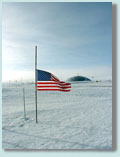 |
 NSF FY04 Budget Request NSF FY04 Budget Request
|
 |
NSF Seeks
2004 Budget of $5.48 Billion; Increase will address priorities of
"immediate national importance"
The National Science Foundation has sent to Congress a fiscal 2004
budget request of $5.48 billion -- an investment representing what
the agency believes will "sustain and build U.S. global leadership
in science, engineering and technology, and help the United States
address priorities of immediate national importance." The increase
sought in 2004 over NSF's 2003 request would amount to about 9 percent.
Although NSF's 2004 request calls for a 60 percent hike in major
research equipment and facilities, the overall 8.5 percent increase
sought for core research and related activities (people, ideas and
tools) is at the heart of NSF's overall budget priorities for the
coming year.
More... (posted
February 3, 2003)
|
 |
 |
| |
NSF
Director Rita Colwell Calls on the Science Community to Engage in
the Policy Debate over Scientific Freedom and National Security
The science community has a responsibility to participate in the
debate over scientific freedom and national security, NSF Director
Rita Colwell asserted in a speech at the annual meeting of the Universities
Research Association on January 30. “We as scientists are passionate
guardians of the free exchange of scientific knowledge for the sake
of enduring scientific progress. We are also citizens who work as
scientists for the progress and endurance of the nation. These are
not mutually exclusive roles or responsibilities. If, however, we
are perceived as well-intentioned and dedicated to our calling,
but aloof from society and self important in our esoteric knowledge,
we’re headed down an unproductive and destructive path. Our objections
to an erosion of scientific openness will be interpreted as whining
and self-serving. It will even engender antagonism.”
More... (posted
February 3, 2003)
|
 |
 |
Photograph showing
typical texture indicative of what was once magma within the
central parts of a batholith (a large intrusion of magma into
rock).
Credit: Photo courtesy of Keith Klepeis, University of Vermont;
NSF |
Earth
Scientists Forge New Understanding of Mountain-Building Dynamics
From volcanic eruptions to earthquakes to catastrophic mudslides,
the geologic processes active in mountain belts affect human societies
every day. Yet, even though mountains are on all continents and
in all ocean basins, scientists still understand relatively little
about the forces that interact to form and destroy mountains, how
mountains change over time, and the relationship between mountains
and Earth's climate. To better understand these dynamics, earth
scientists are now integrating studies across traditional disciplinary
boundaries. In research funded by NSF and published in the January
2003 GSA Today, scientists have demonstrated a new way
to integrate results from observations collected in the field with
laboratory and experimental techniques. The team studied a mountain
belt located in Fiordland, South Island, New Zealand.
More... (posted
February 3, 2003)
|
 |
|
Revelations
in the Ice: Shackleton’s Legacy, Antarctica Today
NSF and the Maryland Science Center will celebrate the legacy of
Antarctic explorer Sir Ernest Shackleton in a day-long event on
February 26 featuring NSF's U.S. Antarctic Program researchers from
Maryland and elsewhere. Antarctica is the only continent where science
serves as the principal expression of national and international
interest. A highlight of the event will be a lecture on “Dinosaurs
On Ice -- Jurassic Dinosaurs from Antarctica” by NSF-funded
researcher William R. Hammer. The lecture will be webcast live.
During the 1990-91 Antarctic field season, Hammer discovered the
remains of Cryolophosaurus ellioti, or "frozen crested reptile."
Among the Antarctic dinosaur's telltale features were its large
skull crest. Hammer's paper describing the extinct creature was
published in the journal Science in 1994.
More... (posted
February 3, 2003)
|
 |
 |
|
The U.S. flag flies
at half-staff at the geographic South Pole and over NSF's Amundsen-Scott
South Pole Station in memory of the seven NASA astronauts who
died aboard the space shuttle Columbia.
Image credit: Jerry Marty/NSF |
|
NSF Joins the NASA Family in Sorrow
NSF Joins the NASA Family in Sorrow
NSF joins the NASA family in sorrow for the loss of seven brave explorers and their ship. Over the centuries,
the quest for knowledge has so often involved high risk. But the passion to explore has driven humankind
to search the depths of the sea, the breadth of continents, and in the last half century, the far reaches of space.
These missions to know and understand are the very definition of our humanness. Along with all Americans,
we take time this week to contemplate the gift of courage of the seven astronauts and to appreciate the
fragile thread we call life. - NSF Director Rita Colwell
(posted February 3, 2003)
|
 |
| |


|

